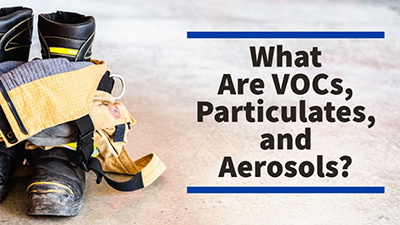
How do VOCs, Particulates, & Aerosols Affect Fire Service?
It is no secret that as a firefighter or first responder, you are exposed to health risks and hazards regularly. One of the most talked about risks in firefighting today is air contamination.
As a firefighter, you use equipment on scene and off to protect yourself from breathing in harmful materials. Volatile organic compounds, particulates, and aerosols all pose a threat to you and your crew. These elements are present on scene, in the apparatus, and back at the station. Have you ever wondered what some of these threats are and why it is so important to reduce their numbers in the air you breathe?
In this article, we are going to help you understand what each of these elements are, why it’s important to act and protect your crew from them, and what questions you should ask when evaluating an air decontamination system.
What is a Volatile Organic Compound or VOC?
According to the American Lung Association, VOCs (volatile organic compounds) are “gases that are emitted into the air from products or processes.” Some volatile organic compounds are proven to be cancer-causing and may react with other gases to form additional air pollutants. These substances are found indoors and outdoors in a variety of products including paint, flooring, adhesives, furniture, wood, gasoline, and more.
For you and your crew, VOCs are prevalent as known and unknown materials burn during a fire. These contaminants cling to your gear and skin and can be breathed in over time. They also continue off-gassing for hours after a call, bringing contaminants with you into the apparatus and station.
VOCs have been linked to an increased risk of developing multiple different cancers. From 2002-2019, 66% of the career firefighter line-of-duty deaths were caused by cancer. When compared to the general population, firefighters have a 9% higher risk of being diagnosed with cancer and a 14% higher risk of dying from cancer according to a NIOSH (National Institute for Occupational Safety and Health) study. Because of this increased risk, it is exceptionally important that you use proper equipment on the scene of a fire, clean that equipment regularly, and invest in gross decon and air decontamination products that can lower the risk for your crew.
What are Particulates?
Particulates are another potentially cancer-causing element prevalent in the fire service. Found in soot and smoke, particulates are sometimes large enough to be seen with the naked eye but small enough to be inhaled into the throat, nose, and lungs. Some particulates are so small they can only be detected using an electron microscope. The United States Environmental Protection Agency defines particulate matter as “a mixture of solid particles and liquid droplets found in the air.
Particulates can be made up of hundreds of types of chemicals, making them a dangerous element for you in the fire service. As these particulates work their way onto your skin or get breathed into your lungs, they can enter your bloodstream and raise your risk of certain cancers and diseases. Even something as simple as storing dirty gloves inside your helmet can increase your risk of exposure.
Particulates in soot and smoke are inevitable in a fire, which is why understanding what they are and how to protect yourself from them is so important.
What are Aerosols?
The term aerosol probably makes you think of hairspray or spray paints that use gas to force a liquid into the air. While these are a form of aerosol, the broader definition is “any tiny solid or liquid particle suspended in a gas.”
How Can Firefighters Protect Themselves?
VOCs, particulates, and aerosols are not issues that will disappear from the fire service. You already use PPE on scene and use gross decon on the fire ground. You know the importance of good handwashing techniques and showering after a call. But what about the air?
There are multiple systems available that help clean the air, but not all systems are created equal. When looking for a system, you should consider which ones were built with fire departments in mind. Here are four questions you should ask yourself when considering air decontamination and filtration systems for your apparatus or station:
- Does this system address all three air contamination threats facing firefighters, including VOCs, particulates, and aerosols?
- Does the system have a filter that can trap and neutralize the particulates?
- Does the system create harmful byproducts when removing the threats from the air?
- Was the system created with fire departments, firefighting personnel, and first responders in mind?
So, what’s next? You can explore CrewProtect and StationProtect.

